Progress report for GW24-013
Project Information
Tea (Camellia sinensis) is a newly emerging specialty crop in the United States and provides an opportunity for Washington crop diversification. The limited availability of tea plant material and limited knowledge and skill for tea plant propagation are major barriers for tea production in Washington and the United States overall. Propagation guides from other states and regions of the world did not work well in Washington and resulted in low success rates.
Our project is evaluating the rooting and plant growth of 14 different tea cultivars during propagation in western Washington, utilizing the propagation method that we developed for one cultivar, Minto Pacific. We are presenting this propagation method to growers in our region through grower conferences, and we will present to peers at the national ASHS conferences in July 2025. In Year 2 of the project, we will provide hands-on training on tea cutting propagation methods to our grower partner at the grower’s farm, we will offer hands-on training to growers and nursery propagators and we will create an online video demonstrating propagation to provide unlimited access to the training. We have developed a guide for propagation and posted it online at our website https://vegetables.wsu.edu/tea/, and in Year 2, we will create a planting guide for tea in western Washington. By Year 3 of this project, we will make tea plants available for Washington nursery growers to collect cuttings.
Research objective:
- Test cutting propagation of 14 tea cultivars
Educational objectives:
- Provide hands-on training on tea cutting propagation method to growers
- Write an extension guide on tea propagation for Western Washington nursery grower and a guide on garden/field planting for customers
- Present research results at conferences
|
|
Aug 2024 |
Sept 2024 |
Oct 2024-Sept 2025 |
Aug 2025 |
Sept 2025 |
Oct 2025-Dec 2025 |
Jan-Sept 2026 |
June 2026 |
Oct 2026-Mar 2027 |
|
Designing experiment, greenhouse setup, mist chamber installation, potting media preparation |
√ |
|
|
√ |
|
|
|
|
|
|
Tea plant propagation trial and hands-on training |
|
√ |
|
|
√ |
|
|
|
|
|
Data collection and analysis |
|
|
√ |
|
|
√ |
√ |
|
|
|
writing report and extension guide, share information to stakeholders |
|
|
|
|
|
√ |
√ |
√ |
|
|
Planting tea plants in the field |
|
|
|
|
|
|
|
√ |
|
|
Data analysis, final report, update extension guide, share information to stakeholders |
|
|
|
|
|
|
|
|
√ |
Cooperators
- - Producer
Research
Objectives:
- Test cutting propagation of 14 tea cultivars
Materials and methods:
We are testing the cutting propagation method that we developed for cv. Minto Pacific. We have completed this experiment one time (Yr1, Sept 2023-Oct 2024) and are repeating the experiment (Yr2, Sept 2024-Oct 2025). The experimental design both years is a randomized complete block with 3 replications, and there were 13 treatments in Yr 1 and 14 treatments in Yr2. The treatments are nine tea cultivars from Mississippi State University (BL1, BL2, Black Sea, Christine’s Choice, Dave’s Fav, Large leaf, Small leaf, Sochi, and var. assamica), four from USDA National Plant Germplasm System (NPGS) in Hilo, HI (Benikaori, Bohea, Yabukita, and Yutaka Midori), and one from a local grower (Minto Pacific, Yr2 only).
In Yr1, there were 20 cuttings per treatment per replication, and in Yr2, there are 15 cuttings (number of cuttings was reduced to accommodate the additional treatment in Yr2). Both years, the bottom end of each cutting was dipped into rooting hormone (Dip’n Grow, Clackamas, OR) then each cutting was placed into a treepot (MT38BT, Stuewe and Sons, Tree Seedling Nursery Containers, Tangent, Oregon) filled with propagation media (peatmoss, vermiculite and perlite in 5:3:2 ratio). Media was watered well prior to sticking the tea cuttings. The treepots with cuttings were then placed in a misting chamber (model #549, Mist Timer II, Drips Inc., Concho, AZ) on the greenhouse bench, set to mist @ 30 s every 1 ½ hours, with bottom heat (Jump start seedling heat mat, 20 x 48, 107 Watts, Johnny’s Selected Seeds, Fairfield, ME). Plants from this experiment will be planted in a field at WSU NWREC in Summer 2025 and 2026 where they will be assessed for production as a new crop for western Washington.
Both years data collection included plant survival, root growth, vegetative growth, and overall plant health. Plant survival was measured once a month as the total number of alive cuttings per plot from February through October. Root growth was measured as the length of the longest root, number of roots, and root area using ImageJ from three randomly selected cuttings per plot 1 year after taking cuttings. Vegetative growth was measured as plant height (cm) and number of leaves, collected for five representative plants per plot once a month from February through October. In Yr1 overall plant health was recorded once a month from February through October for 5 representative plants per plot, on a 5-point scale where 1 = very poor, 2 = poor, 3 = average, 4 = good, and 5 = very good. In Yr2 overall plant health is measured for 7 representative plants per plot once a month from March through October, as number of unhealthy leaves, percentage of unhealthy leaves, number of unhealthy buds, number of dormant vs active buds, and percentage of unhealthy buds.
All data presented in this report are means. Data are being subjected to analysis of variance and Tukey’s HSD using RStudio and statistical results will be available in reporting year 2.
Plant survival. In Yr1 March overall average plant survival was 78%, and cv. Large Leaf had the highest survival (100%), and cv. BL1 had the lowest survival (53%) (Fig. 1). In Yr1 October overall average plant survival was 30%, and cv. Christine’s Choice had the highest survival (47%), and cv. Benikaori had the lowest survival (13%) (Fig. 2). In Yr2 March overall average plant survival was 68%, and cv. Minto Pacific had the highest survival (98%), Christine’s Choice had the second highest survival (91%), and cv. Benikaori had the lowest survival (33%) (Fig. 3).
Plant roots. In Yr1, the overall average root length was 26.7 cm, and cv. BL2 had the longest roots (33 cm) and cv. Benikaori had the shortest roots (20.9 cm) (Fig. 4). The overall average number of roots was 7.6, and cv. Large Leaf had the greatest number of roots (10.3) and cv. BL1 had the least number of roots (4.33) (Fig. 4).
Plant height. In Yr1 March, the overall average plant height was 2.1 cm, and cv. Sochi had the tallest plants (7.5 cm) and cv. Bohea had the smallest (0.9 cm) (Fig. 5). In Yr1 October, the overall average plant height was 43.0 cm, and cv. Assamica had the tallest plants (58.2 cm) and cv. Yabukita had the smallest (12.4 cm) (Fig. 6). In Yr2 March, the overall average plant height was 3.6 cm, and cv. Sochi had the tallest plants (6.5 cm) and cv. Small Leaf had the smallest (2.1 cm) (Fig. 7).
Leaf number. In Yr1 March, the overall average number of leaves was 2.6, and cv. Sochi had the greatest number of leaves (5.6) and cv. Christine’s Choice had the lowest number of leaves (1.6) (Fig. 8). In Yr1 October, the overall average number of leaves was 19.1, and cv. Assamica had the greatest number of leaves (32.4) and cv. Yabukita had the lowest number of leaves (4.8) (Fig. 9). In Yr2 March, the overall average number of leaves was 3.6, and cv. Bohea had the greatest number of leaves (5.8) and cv. Black Sea had the lowest number of leaves (1.8) (Fig. 10).
Plant health. The data on plant health for Yr1 is being assessed for statistical analysis, and Yr2 data is being recorded.
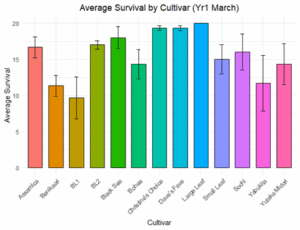
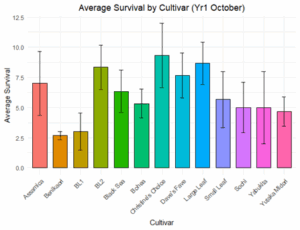
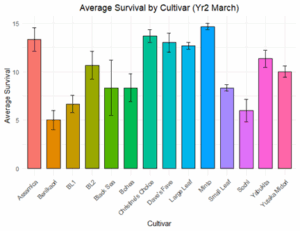
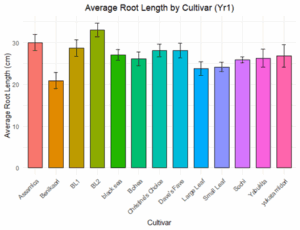
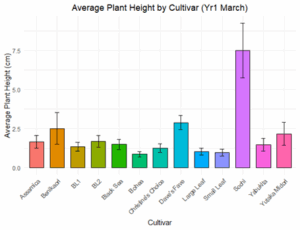
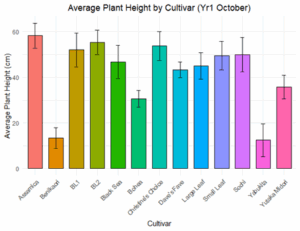
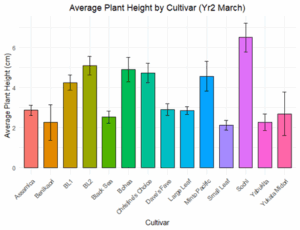
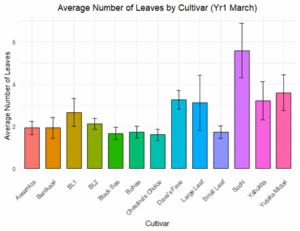
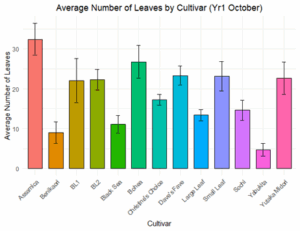
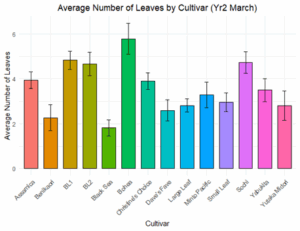
Research outcomes
The cultivars included in this greenhouse propagation experiment should be evaluated for successful transition and establishment in field plantings. These studies should include: overwintering success including cold hardiness testing; pest and pathogen pressures, and control methods; foliage production, and tea leaf quality and yield; and fertilizer and irrigation rates and frequency. There is a lack of published scientific literature on tea cultivar selection for different regions and crop management in Washington and the U.S. overall.
Tissue culture of tea should be considered for future research to create a source of disease-free plant material and to rapidly propagate cultivars that currently only have limited availability. There is a lack of published literature on tissue culture for tea in the U.S. Studies could first focus on surface sterilization, followed by media composition for the initiation of tea explants in tissue culture. Studies based in the Pacific Northwest could first utilize the cultivar Minto Pacific to create a basic protocol, before attempting other cultivars.
Education and Outreach
Participation summary:
- Introduction to tea cutting propagation and hands-on methods training provided at NWREC to interested Master Gardeners, growers and nursery propagators in spring and summer 2025. Graduate student McKenzie Shelton will lead trainings, which will include potting media selection for low pH, collection of tea shoots from mother plant, processing tea shoots into one-node cuttings, scoring the shoots, rooting hormone application, and sticking cuttings in tree pots. Hands-on propagation training will be offered to Sakuma Brothers Farms in September 2025, to enable farm personnel to participate.
- We have written the first draft of the Extension publication “Tea ‘Camellia sinensis’ Production for Western Washington” that includes information on tea cultivars, site selection and preparation, planting and establishment, preventing winter damage, pruning, pest management, tea leaf production and processing, and economic expectations for western Washington. We have also written a guide for tea plant cutting propagation based on the methods and results from our experiments. Both guides are for growers and nurseries. We will next simplify the information to create a guide for home gardeners.
- We presented experiment results at the San Juan Islands Agricultural Summit in February 2025. A PowerPoint presentation was given including cutting propagation methods and results to date. This PowerPoint presentation will be used as the foundation for a video that we will create to describe tea cutting propagation using the methods we have developed in this project.
- We have submitted 2 abstracts for presentation at the 2025 American Society for Horticultural Science conference. We are preparing an abstract to submit to the Plant Propagators Society Western Region meeting in September 2025.
- We will post all Extension and outreach materials on our tea webpage https://vegetables.wsu.edu/tea/.
Presenting our project results at the San Juan Islands Agricultural Summit gave growers the opportunity to ask us questions about rooting cuttings, cultivar suitability for our region, site selection, and preparing plants and tea leaves for sale. We wrote responses to these questions and incorporated this information into the guides that we are writing. This experience also provided MS student McKenzie Shelton feedback to revise the presentation for development of a video that we will post on our website so it is freely accessible.